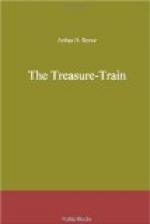“There’s carbon monoxide in the air, Kennedy!” he exclaimed. “You know how this gas affects birds.”
Kennedy looked over intently. The canary had begun to show evident signs of distress over something.
“It must be that this stove is defective,” pursued MacLeod, picking up the poor little bird and carrying it quickly into the fresh air, where it could regain its former liveliness. Then, when he returned, he added, “There must be some defect in the stove or the draught that makes it send out the poisonous gas.”
“There’s some gas,” agreed Kennedy. “It must have cleared away mostly, though, or we couldn’t stand it ourselves.”
Craig continued to look about the car and the building, in the vain hope of discovering some other clue. Had Mrs. Snedden been killed by the carbonic oxide? Was it a case of gas poisoning? Then, too, why had she been here at all? Who had shut her up? Had she been overcome first and, in a stupor, been unable to move to save herself? Above all, what had this to do with the mysterious phantom slayer that had wrecked so much of the works in less than a week?
It was quite late in the afternoon when, at last, people came from the town and took away both the body of Mrs. Snedden and Jackson’s car. Snedden could only stare and work his fingers, and after we had seen him safely in the care of some one we could trust Kennedy, MacLeod, and I climbed into MacLeod’s car silently.
“It’s too deep for me,” acknowledged MacLeod. “What shall we do next?”
“Surely that fellow must have my pictures developed by this time,” considered Kennedy. “Shoot back there.”
“They came out beautifully—all except one,” reported the druggist, who was somewhat of a camera fiend himself. “That’s a wonderful system, sir.”
Kennedy thanked him for his trouble and took the prints. With care he pieced them together, until he had several successive panoramas of the country taken from various elevations of the parachute. Then, with a magnifying-glass, he went over each section minutely.
“Look at that!” he pointed out at last with the sharp tip of a pencil on one picture.
In what looked like an open space among some trees was a tiny figure of a man. It seemed as if he were hacking at something with an ax. What the something was did not appear in the picture.
“I should say that it was half a mile, perhaps a mile, farther away than that grove,” commented Kennedy, making a rough calculation.
“On the old Davis farm,” considered MacLeod. “Look and see if you can’t make out the ruins of a house somewhere near-by. It was burned many years ago.”
“Yes, yes,” returned Kennedy, excitedly; “there’s the place! Do you think we can get there in a car before it’s dark?”
“Easily,” replied MacLeod.
It was only a matter of minutes before we three were poking about in a tangle of wood and field, seeking to locate the spot where Kennedy’s apparatus had photographed the lone axman.




